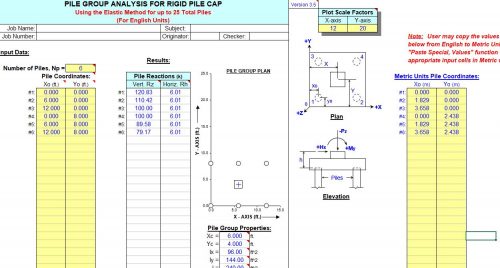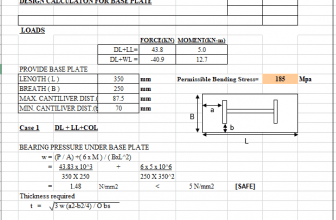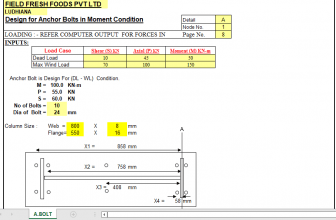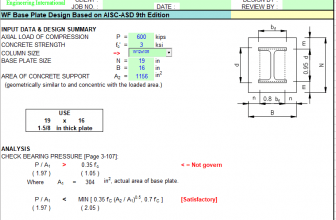
“PILEGRP” Program
| Program Description: |
| “PILEGRP” is a spreadsheet program written in MS-Excel for the purpose of analysis of pile groups with rigid |
| caps using the “elastic method”. Specifically, the properties of the pile group are calculated, and then based |
| upon the applied vertical and horizontal loadings, the vertical and horizontal pile reactions are calculated. |
| There is also a worksheet to check beam and punching shear in the pile cap for a single corner pile, for the |
| purpose of estimating the required pile cap thickness and subsequent pile cap weight. |
| This program is a workbook consisting of ten (10) worksheets, described as follows: |
| Worksheet Name |
| Doc |
| Piles (<=25) |
| Piles (<=25)(metric) |
| Piles (<=75) |
| Piles (<=75)(metric) |
| Piles (<=300) |
| Piles (<=300)(metric) |
| Piles (<=400) |
| Piles (<=400)(metric) |
| Corner Pile Shear |
| Program Assumptions and Limitations: |
| 1. The Pile Group worksheets assume a minimum of 2 piles and a maximum of either 25, 75, 300, or 400 piles |
| for a pile group. |
| 2. This program uses the “elastic method” of analysis, assuming that the pile cap is in fact “rigid”, so that the |
| applied loads are linearly distributed among the piles. A common “rule-of-thumb” is to assume a pile cap |
| thickness equal to least 1/10 of the longest dimension (length or width) of the pile cap. All piles are assumed |
| to be vertical, and of equal size and length (stiffness). Battered piles are NOT permitted. The tops of all piles |
| are assumed at the same level. |
| 3. This program assumes an orthogonal X-Y-Z coordinate system. All piles and piers MUST BE located in the |
| “positive” (1st) quadrant. “Negative” pile or pier/loading location coordinates are NOT permitted. |
| “Right-Hand-Rule” sign convention is used for all applied forces and moments at pier locations. |
| 4. The piles and piers/loadings can be numbered in any desired order. However, the user should make |
| sure to either clear the contents of all spreadsheet cells that are not used for input or those cell values should |
| be input = 0. All piles and piers/loadings MUST BE input in proper numerical sequence with no “breaks” in |
| the numerical order of input data. |
| 5. This program does NOT include the weight of the pile cap or piers in the calculation of the vertical pile reactions. |
| However, the total weight of the pile cap and piers may be included by assuming an additional “ficticious” pier |
| located at the centroid of the pile cap plan area, and applying the total weight at that “pier” location. |
| 6. This program does NOT check the actual calculated pile reactions (vertical and horizontal) against known |
| or given allowable pile reactions for downward, uplift, or lateral cases. This is done so that the extent of any |
| acceptable overstress is left up to the judgement of the user. However, in all cases this must be checked by |
| the user. |
| 7. This program does NOT check the shear (beam-type or punching) nor the flexural requirements of the pile cap. |
| This must be done independently by the user. |
| 8. This program contains numerous “comment boxes” which contain a wide variety of information including |
| explanations of input or output items, equations used, data tables, etc. (Note: presence of a “comment box” |
| is denoted by a “red triangle” in the upper right-hand corner of a cell. Merely move the mouse pointer to the |
| desired cell to view the contents of that particular “comment box”.) |






